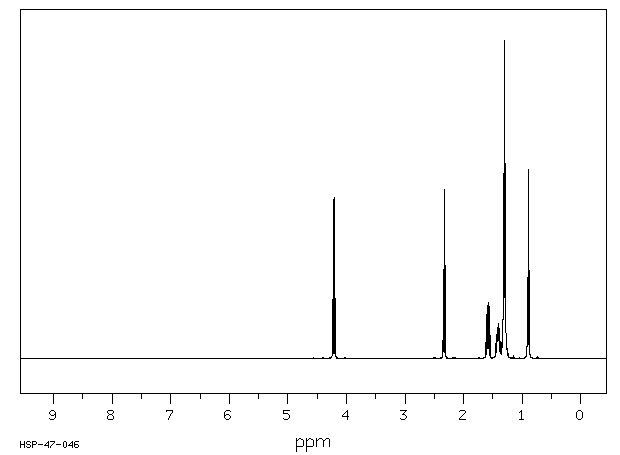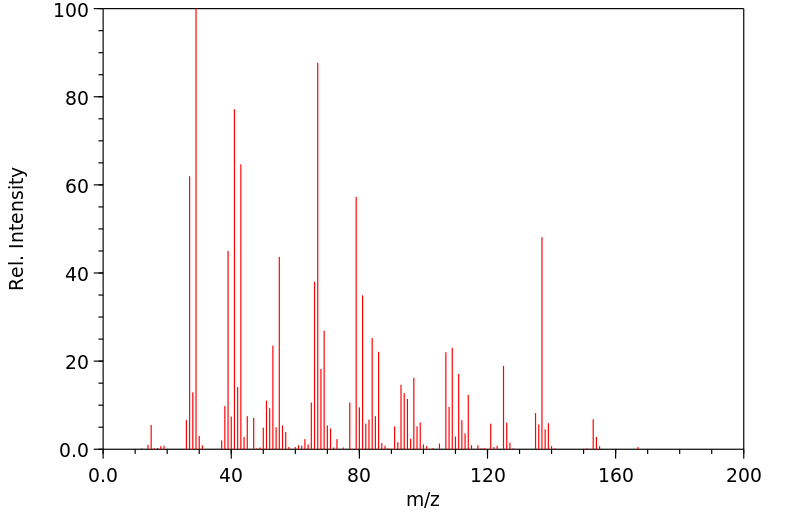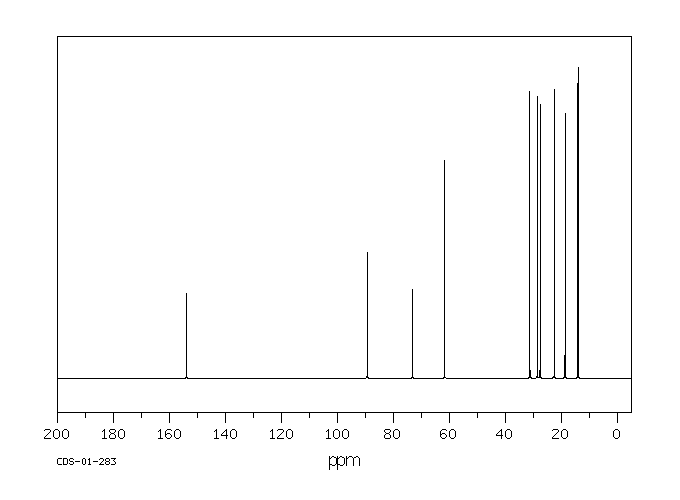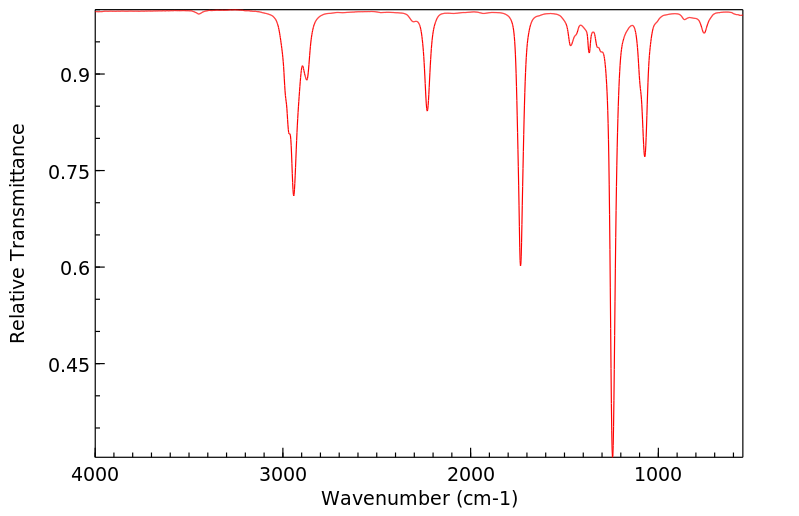2-壬炔酸乙酯 | 10031-92-2
中文名称
2-壬炔酸乙酯
中文别名
——
英文名称
ethyl non-2-ynoate
英文别名
ethyl 2-nonynoate
CAS
10031-92-2
化学式
C11H18O2
mdl
MFCD00036553
分子量
182.263
InChiKey
BFZNMUGAZYAMTG-UHFFFAOYSA-N
BEILSTEIN
——
EINECS
——
-
物化性质
-
计算性质
-
ADMET
-
安全信息
-
SDS
-
制备方法与用途
-
上下游信息
-
文献信息
-
表征谱图
-
同类化合物
-
相关功能分类
-
相关结构分类
物化性质
-
沸点:121-122 °C13 mm Hg(lit.)
-
密度:0.904 g/mL at 25 °C(lit.)
-
闪点:>230 °F
-
LogP:4.62
-
物理描述:Colourless oily liquid; Green, violet-like aroma
-
溶解度:Soluble in oils; Insoluble in water
-
折光率:1.450-1.456
计算性质
-
辛醇/水分配系数(LogP):4.1
-
重原子数:13
-
可旋转键数:6
-
环数:0.0
-
sp3杂化的碳原子比例:0.727
-
拓扑面积:26.3
-
氢给体数:0
-
氢受体数:2
安全信息
-
TSCA:Yes
-
危险品标志:Xi
-
安全说明:S26,S36
-
危险类别码:R36/37/38
-
WGK Germany:3
-
海关编码:2916190090
SDS
2-壬炔酸乙酯 修改号码:5
模块 1. 化学品
产品名称: Ethyl 2-Nonynoate
修改号码: 5
模块 2. 危险性概述
GHS分类
物理性危害 未分类
健康危害 未分类
环境危害 未分类
GHS标签元素
图标或危害标志 无
信号词 无信号词
危险描述 无
防范说明 无
模块 3. 成分/组成信息
单一物质/混和物 单一物质
化学名(中文名): 2-壬炔酸乙酯
百分比: ....
CAS编码: 10031-92-2
俗名: 2-Nonynoic Acid Ethyl Ester
分子式: C11H18O2
模块 4. 急救措施
吸入: 将受害者移到新鲜空气处,保持呼吸通畅,休息。若感不适请求医/就诊。
皮肤接触: 立即去除/脱掉所有被污染的衣物。用水清洗皮肤/淋浴。
若皮肤刺激或发生皮疹:求医/就诊。
眼睛接触: 用水小心清洗几分钟。如果方便,易操作,摘除隐形眼镜。继续清洗。
如果眼睛刺激:求医/就诊。
食入: 若感不适,求医/就诊。漱口。
紧急救助者的防护: 救援者需要穿戴个人防护用品,比如橡胶手套和气密性护目镜。
模块 5. 消防措施
合适的灭火剂: 干粉,泡沫,二氧化碳
不适用的灭火剂: 水(有可能扩大灾情。)
2-壬炔酸乙酯 修改号码:5
模块 5. 消防措施
特定方法: 从上风处灭火,根据周围环境选择合适的灭火方法。
非相关人员应该撤离至安全地方。
周围一旦着火:如果安全,移去可移动容器。
消防员的特殊防护用具: 灭火时,一定要穿戴个人防护用品。
模块 6. 泄漏应急处理
个人防护措施,防护用具, 使用个人防护用品。远离溢出物/泄露处并处在上风处。确保足够通风。
紧急措施: 泄露区应该用安全带等圈起来,控制非相关人员进入。
环保措施: 防止进入下水道。
控制和清洗的方法和材料: 用合适的吸收剂(如:旧布,干砂,土,锯屑)吸收泄漏物。一旦大量泄漏,筑堤控
制。附着物或收集物应该立即根据合适的法律法规废弃处置。
模块 7. 操作处置与储存
处理
技术措施: 在通风良好处进行处理。穿戴合适的防护用具。防止烟雾产生。处理后彻底清洗双手
和脸。
注意事项: 如果蒸气或浮质产生,使用通风、局部排气。
操作处置注意事项: 避免接触皮肤、眼睛和衣物。
贮存
储存条件: 保持容器密闭。存放于凉爽、阴暗处。
远离不相容的材料比如氧化剂存放。
包装材料: 依据法律。
模块 8. 接触控制和个体防护
工程控制: 尽可能安装封闭体系或局部排风系统,操作人员切勿直接接触。同时安装淋浴器和洗
眼器。
个人防护用品
呼吸系统防护: 防毒面具。依据当地和政府法规。
手部防护: 防护手套。
眼睛防护: 安全防护镜。如果情况需要,佩戴面具。
皮肤和身体防护: 防护服。如果情况需要,穿戴防护靴。
模块 9. 理化特性
液体
外形(20°C):
外观: 透明
颜色: 无色-几乎无色
气味: 无资料
pH: 无数据资料
熔点: 无资料
沸点/沸程 125 °C/2.3kPa
闪点: 104°C
爆炸特性
爆炸下限: 无资料
爆炸上限: 无资料
密度: 0.91
溶解度:
[水] 无资料
[其他溶剂] 无资料
2-壬炔酸乙酯 修改号码:5
模块 10. 稳定性和反应性
化学稳定性: 一般情况下稳定。
危险反应的可能性: 未报道特殊反应性。
须避免接触的物质 氧化剂
危险的分解产物: 一氧化碳, 二氧化碳
模块 11. 毒理学信息
急性毒性: 无资料
对皮肤腐蚀或刺激: 无资料
对眼睛严重损害或刺激: 无资料
生殖细胞变异原性: 无资料
致癌性:
IARC = 无资料
NTP = 无资料
生殖毒性: 无资料
模块 12. 生态学信息
生态毒性:
鱼类: 无资料
甲壳类: 无资料
藻类: 无资料
残留性 / 降解性: 无资料
潜在生物累积 (BCF): 无资料
土壤中移动性
log水分配系数: 无资料
土壤吸收系数 (Koc): 无资料
亨利定律 无资料
constaNT(PaM3/mol):
模块 13. 废弃处置
如果可能,回收处理。请咨询当地管理部门。建议在装有后燃和洗涤装置的化学焚烧炉中焚烧。废弃处置时请遵守
国家、地区和当地的所有法规。
模块 14. 运输信息
联合国分类: 与联合国分类标准不一致
UN编号: 未列明
模块 15. 法规信息
《危险化学品安全管理条例》(2002年1月26日国务院发布,2011年2月16日修订): 针对危险化学品的安全使用、
生产、储存、运输、装卸等方面均作了相应的规定。
2-壬炔酸乙酯 修改号码:5
模块16 - 其他信息
N/A
模块 1. 化学品
产品名称: Ethyl 2-Nonynoate
修改号码: 5
模块 2. 危险性概述
GHS分类
物理性危害 未分类
健康危害 未分类
环境危害 未分类
GHS标签元素
图标或危害标志 无
信号词 无信号词
危险描述 无
防范说明 无
模块 3. 成分/组成信息
单一物质/混和物 单一物质
化学名(中文名): 2-壬炔酸乙酯
百分比: ....
CAS编码: 10031-92-2
俗名: 2-Nonynoic Acid Ethyl Ester
分子式: C11H18O2
模块 4. 急救措施
吸入: 将受害者移到新鲜空气处,保持呼吸通畅,休息。若感不适请求医/就诊。
皮肤接触: 立即去除/脱掉所有被污染的衣物。用水清洗皮肤/淋浴。
若皮肤刺激或发生皮疹:求医/就诊。
眼睛接触: 用水小心清洗几分钟。如果方便,易操作,摘除隐形眼镜。继续清洗。
如果眼睛刺激:求医/就诊。
食入: 若感不适,求医/就诊。漱口。
紧急救助者的防护: 救援者需要穿戴个人防护用品,比如橡胶手套和气密性护目镜。
模块 5. 消防措施
合适的灭火剂: 干粉,泡沫,二氧化碳
不适用的灭火剂: 水(有可能扩大灾情。)
2-壬炔酸乙酯 修改号码:5
模块 5. 消防措施
特定方法: 从上风处灭火,根据周围环境选择合适的灭火方法。
非相关人员应该撤离至安全地方。
周围一旦着火:如果安全,移去可移动容器。
消防员的特殊防护用具: 灭火时,一定要穿戴个人防护用品。
模块 6. 泄漏应急处理
个人防护措施,防护用具, 使用个人防护用品。远离溢出物/泄露处并处在上风处。确保足够通风。
紧急措施: 泄露区应该用安全带等圈起来,控制非相关人员进入。
环保措施: 防止进入下水道。
控制和清洗的方法和材料: 用合适的吸收剂(如:旧布,干砂,土,锯屑)吸收泄漏物。一旦大量泄漏,筑堤控
制。附着物或收集物应该立即根据合适的法律法规废弃处置。
模块 7. 操作处置与储存
处理
技术措施: 在通风良好处进行处理。穿戴合适的防护用具。防止烟雾产生。处理后彻底清洗双手
和脸。
注意事项: 如果蒸气或浮质产生,使用通风、局部排气。
操作处置注意事项: 避免接触皮肤、眼睛和衣物。
贮存
储存条件: 保持容器密闭。存放于凉爽、阴暗处。
远离不相容的材料比如氧化剂存放。
包装材料: 依据法律。
模块 8. 接触控制和个体防护
工程控制: 尽可能安装封闭体系或局部排风系统,操作人员切勿直接接触。同时安装淋浴器和洗
眼器。
个人防护用品
呼吸系统防护: 防毒面具。依据当地和政府法规。
手部防护: 防护手套。
眼睛防护: 安全防护镜。如果情况需要,佩戴面具。
皮肤和身体防护: 防护服。如果情况需要,穿戴防护靴。
模块 9. 理化特性
液体
外形(20°C):
外观: 透明
颜色: 无色-几乎无色
气味: 无资料
pH: 无数据资料
熔点: 无资料
沸点/沸程 125 °C/2.3kPa
闪点: 104°C
爆炸特性
爆炸下限: 无资料
爆炸上限: 无资料
密度: 0.91
溶解度:
[水] 无资料
[其他溶剂] 无资料
2-壬炔酸乙酯 修改号码:5
模块 10. 稳定性和反应性
化学稳定性: 一般情况下稳定。
危险反应的可能性: 未报道特殊反应性。
须避免接触的物质 氧化剂
危险的分解产物: 一氧化碳, 二氧化碳
模块 11. 毒理学信息
急性毒性: 无资料
对皮肤腐蚀或刺激: 无资料
对眼睛严重损害或刺激: 无资料
生殖细胞变异原性: 无资料
致癌性:
IARC = 无资料
NTP = 无资料
生殖毒性: 无资料
模块 12. 生态学信息
生态毒性:
鱼类: 无资料
甲壳类: 无资料
藻类: 无资料
残留性 / 降解性: 无资料
潜在生物累积 (BCF): 无资料
土壤中移动性
log水分配系数: 无资料
土壤吸收系数 (Koc): 无资料
亨利定律 无资料
constaNT(PaM3/mol):
模块 13. 废弃处置
如果可能,回收处理。请咨询当地管理部门。建议在装有后燃和洗涤装置的化学焚烧炉中焚烧。废弃处置时请遵守
国家、地区和当地的所有法规。
模块 14. 运输信息
联合国分类: 与联合国分类标准不一致
UN编号: 未列明
模块 15. 法规信息
《危险化学品安全管理条例》(2002年1月26日国务院发布,2011年2月16日修订): 针对危险化学品的安全使用、
生产、储存、运输、装卸等方面均作了相应的规定。
2-壬炔酸乙酯 修改号码:5
模块16 - 其他信息
N/A
上下游信息
-
上游原料
中文名称 英文名称 CAS号 化学式 分子量 2-壬炔酸 non-2-ynoic acid 1846-70-4 C9H14O2 154.209
反应信息
-
作为反应物:描述:参考文献:名称:手性1,3,2-二氮杂磷烯作为对映选择性共轭还原的催化分子氢化物摘要:1,2,3,2-二氮杂二膦烯原子具有极化的PH键,并以分子氢化物形式出现。本文报道了一类手性,构象受限的甲氧基-1,3,2-二氮杂磷腈催化剂。我们证明了它们在α,β-不饱和羰基衍生物(包括烯酮,酰基吡咯和酰胺)的不对称1,4-还原反应中的催化潜能,其对映选择性高达95.5:4.5 erDOI:10.1002/anie.201801300
-
作为产物:描述:参考文献:名称:Wenkert,E.; McPherson,C.A., Synthetic Communications, 1972, vol. 2, p. 331 - 334摘要:DOI:
文献信息
-
Visible-Light-Induced Nickel-Catalyzed Cross-Coupling with Alkylzirconocenes from Unactivated Alkenes作者:Yadong Gao、Chao Yang、Songlin Bai、Xiaolei Liu、Qingcui Wu、Jing Wang、Chao Jiang、Xiangbing QiDOI:10.1016/j.chempr.2019.12.010日期:2020.3Transition-metal-catalyzed cross-coupling reactions between naturally abundant sp3-hybridized carbon centers facilitate access to diverse molecules with complex three-dimensional structures. Organometallic compounds are among one of the most powerful reagents that are broadly used in carbon–carbon bond formations. Although sp2-hybridized organometallic compounds are widely employed in cross-couplings, sp3-hybridized自然丰富的sp 3-杂化碳中心之间的过渡金属催化交叉偶联反应有助于获得具有复杂三维结构的各种分子。有机金属化合物是最强大的试剂之一,广泛用于碳-碳键的形成。尽管sp 2-杂化的有机金属化合物广泛用于交叉偶联,但是sp 3-杂化的有机金属偶联剂的开发较少。在这里,我们报告可见光诱导的单个镍催化的C(sp 3)–C(sp 3),C(sp 3)–C(sp 2)和C(sp 3)–C(sp)使用烷基锆茂的交叉偶联反应,该反应很容易从末端或内部未活化的烯烃通过加氢锆和链步反应就地生成。该方法温和,适用于多种底物,包括伯,仲,叔烷基,芳基,烯基,炔基卤化物和各种烯烃。机理研究表明,镍催化的自由基交叉偶联是一种新颖的途径,代表了锆锆茂的首次可见光诱导的转变。
-
Palladium-catalyzed cascade carboesterification of norbornene with alkynes作者:Wanqing Wu、Can Li、Jianxiao Li、Huanfeng JiangDOI:10.1039/c8ob01799a日期:——An efficient and convenient palladium-catalyzed cascade carboesterification of norbornenes (NBE) with alkynes has been accomplished to afford functionalized α-methylene γ-lactone and tetrahydrofuran derivatives in good to excellent yields. This new strategy exhibits excellent atom- and step-economy, good functional group tolerance and broad substrate scope. In particular, NBE-palladium species was
-
Asymmetric synthesis of chiral β-alkynyl carbonyl and sulfonyl derivatives via sequential palladium and copper catalysis作者:Barry M. Trost、James T. Masters、Benjamin R. Taft、Jean-Philip LumbDOI:10.1039/c6sc01724j日期:——A sequential catalysis strategy for the synthesis of chiral [small beta]-alkynyl carbonyl and sulfonyl derivatives.用于合成手性[小β]-炔基羰基和磺酰基衍生物的顺序催化策略。
-
Highly Stereoselective Generation of Complex <i>Oxy</i>-Bicyclic Scaffolds <i>via</i> an Atom-Economic Pd(II)-Catalyzed Hydroalkynylation, Isomerization and Diels–Alder Cycloaddition Sequence作者:Ruwei Shen、Ke Chen、Qiulin Deng、Jianjun Yang、Lixiong ZhangDOI:10.1021/ol500101b日期:2014.2.21Pd(II)-catalyzed hydroalkynylation, alkyne-allene isomerization, and Diels–Alder cycloaddition is reported. The reaction employs readily available starting substrates, proceeds in a highly ordered fashion, features high regio- and stereoselectivity, and tolerates a wide range of functionality and structural motifs, thus offering an attractive strategy for producing new molecular complexity and diversity from easily
-
<i>trans</i>-Hydroboration<i>vs.</i>1,2-reduction: divergent reactivity of ynones and ynoates in Lewis-base-catalyzed reactions with pinacolborane作者:You Zi、Fritz Schömberg、Fabian Seifert、Helmar Görls、Ivan VilotijevicDOI:10.1039/c8ob01343h日期:——
In the presence of phosphine catalyst and pinacolborane, ynones undergo 1,2-reduction while ynoates undergo
trans -hydroboration. Mechanistic insights into the two competing pathways lay grounds for control of selectivity in these processes.
表征谱图
-
氢谱1HNMR
-
质谱MS
-
碳谱13CNMR
-
红外IR
-
拉曼Raman
-
峰位数据
-
峰位匹配
-
表征信息
同类化合物
(±)17,18-二HETE
(±)-辛酰肉碱氯化物
(Z)-5-辛烯甲酯
(Z)-4-辛烯酸
(R)-甲羟戊酸锂盐
(R)-普鲁前列素,游离酸
(R,R)-半乳糖苷
(E)-4-庚烯酸
(E)-4-壬烯酸
(E)-4-十一烯酸
(9Z,12E)-十八烷二烯酸甲酯
(6E)-8-甲基--6-壬烯酸甲基酯-d3
(3R,6S)-rel-8-[2-(3-呋喃基)-1,3-二氧戊环-2-基]-3-羟基-2,6-二甲基-4-辛酮
龙胆二糖
黑曲霉二糖
黄质霉素
麦芽酮糖一水合物
麦芽糖醇
麦芽糖酸
麦芽糖基蔗糖
麦芽糖一水合物
麦芽糖
鳄梨油酸乙酯
鲸蜡醇蓖麻油酸酯
鲸蜡醇油酸酯
鲸蜡硬脂醇硬脂酸酯
鲸蜡烯酸脂
鲸蜡基花生醇
鲫鱼酸
鲁比前列素
鲁比前列素
高级烷基C16-18-醇
高甲羟戊酸
高效氯氰菊酯
高-gamma-亚油酸
马来酸烯丙酯
马来酸氢异丙酯
马来酸氢异丁酯
马来酸氢丙酯
马来酸氢1-[2-(2-羟基乙氧基)乙基]酯
马来酸单乙酯
马来酸单丁酯
马来酸二辛酯
马来酸二癸酯
马来酸二甲酯
马来酸二烯丙酯
马来酸二正丙酯
马来酸二戊基酯
马来酸二异壬酯
马来酸二异丙酯










